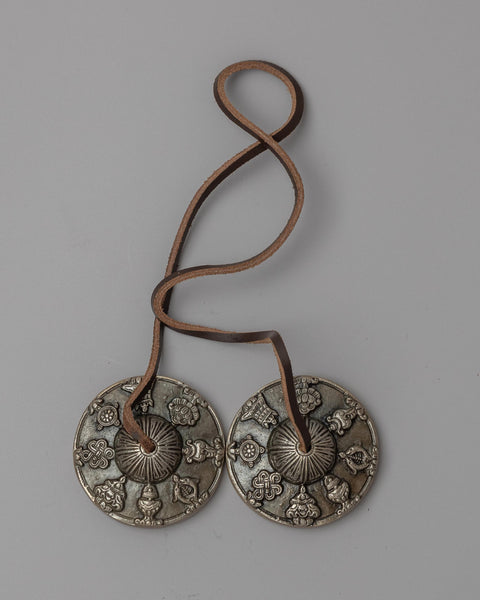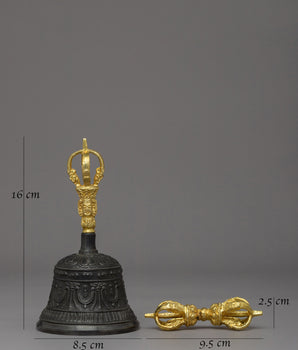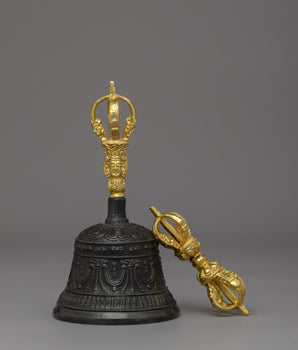Tibetan Tingsha Bells: A Resonance of Harmony and Spirituality
The captivating resonance of Tibetan Tingsha Bells serves as a profound emblem of spirituality and cultural legacy. Rooted in Tibetan Buddhism, these traditional instruments are essential in meditation, healing, and religious rituals. Beyond being a mere call to prayer or a meditation signal, their crystalline, resonant tones guide individuals into a serene realm of tranquility and mindfulness.
Key Takeaways
- Tibetan Tingsha Bells are crucial in Buddhist practices for meditation and healing.
- They produce a unique, clear, and resonating sound.
- Made primarily of bronze, their composition is significant for their sonic quality.
- These bells have transcended religious boundaries for various spiritual and secular contexts.
Historical Background: The Origins
Tibetan Tingsha Bells boast a history spanning centuries, intricately woven into the fabric of Tibetan Buddhism. Originating in the Himalayan regions, these bells, initially employed by Buddhist monks and spiritual leaders, transcend their musical function to carry profound spiritual significance. Beyond their melodic charm, these bells function as sacred tools, facilitating meditation and prayer within the realm of Tibetan spirituality.
Evolution Over Time
Through the passage of centuries, Tingsha bells have undergone a transformative evolution. Originating in monastic life, these bells have transitioned beyond their initial exclusive usage, permeating into lay practices.
Their influence extends far beyond the borders of Tibet, garnering popularity across diverse regions in Asia and eventually integrating into Western cultures. This shift from a religious artifact to a versatile tool utilized in spiritual and secular contexts underscores their universal appeal and adaptability.
Uses and Significance of Tibetan Tingsha Bells
Click here to view our Tibetan Tingsha Bells
In Meditation and Healing
Tingsha bells find frequent application in meditation and healing practices, with their resonant sound believed to clear the mind, facilitating deeper states of meditation. In the realm of healing, the vibration of these bells is thought to instill a sense of balance and inner peace, rendering them a popular tool in diverse therapeutic contexts.
Rituals and Ceremonies
Within Buddhist rituals, Tingsha bells play pivotal roles, marking the commencement and conclusion of meditation sessions, providing focus during chanting, and participating in various ceremonies. The sound of the bells is credited with purifying the atmosphere, dispelling negative energies, and summoning protective deities, establishing their integral role in numerous religious ceremonies.
Tingsha Bells Benefits: The Sound and Its Impact
- Quality of Sound
The enchanting sound of Tingsha bells possesses a distinctive allure, distinguished by a pure, penetrating tone that resonates clearly and endures for a substantial duration. This sonic quality is integral to their application, believed to cut through distractions and foster heightened awareness and focus.
- Psychological and Spiritual Effects
The influence of Tingsha bells extends across both psychological and spiritual realms. Psychologically, the sound has a stress-reducing effect, instilling a sense of calm. On a spiritual level, it amplifies mindfulness, enriches meditation practices, and facilitates a connection with higher states of consciousness.
Tibetan Tingsha bells, with their distinctive cymbal-like appearance and resonant sound, are rich in iconography and attributes that reflect Tibetan Buddhist culture and symbolism.
- Spiritual Significance
Within Tibetan Buddhism, the sound emanating from Tingsha is believed to invoke the presence of deities, positioning it as a tool for ritual invocation. Additionally, the sound is perceived as purifying and can dispel negative energies.
- Usage in Rituals and Practices
Tingsha bells are crucial in diverse Buddhist practices, including meditation, prayer, and ceremonial rituals. Their integration with other ritual instruments like singing bowls and gongs is standard, contributing to the richness of the proper experience.
Tibetan Tingsha bells, known for their clear, resonant sounds, are traditional ritual instruments used in Buddhist practices. These bells' manufacturing process and materials are steeped in tradition and craftsmanship.
Physical Attributes & Iconography
-
Mantras
Many Tingsha bells feature inscriptions of mantras, with "Om Mani Padme Hum" being a prevalent choice. This mantra, rooted in compassion, holds profound importance in Tibetan Buddhism. -
Deity Images
Certain Tingsha bells are adorned with depictions of Buddhist deities, such as Buddha, Tara, or Padmasambhava. Beyond their decorative function, these images invoke the qualities or blessings associated with the depicted deity. -
Mandalas and Geometric Patterns
Mandalas, symbolic representations of the universe in Buddhism, can be intricately designed on some Tingsha bells. These elaborate patterns serve as aids for meditation and spiritual guidance. -
Eight Auspicious Symbols

Tingsha bells are frequently embellished with the Eight Auspicious Symbols of Buddhism. These symbols encompass the Conch Shell (symbolizing the dissemination of Buddhist teachings), the Lotus (representing purity and enlightenment), the Wheel of Dharma (signifying Buddhist law), the Parasol (associated with protection and royalty), the Endless Knot (representing eternity and interconnectedness), the Pair of Golden Fish (symbolic of happiness and freedom), the Treasure Vase (linked to spiritual and material abundance), and the Victory Banner (indicating the triumph of Buddhist teachings).
Craftmanship & Manufacturing Process
- Casting: The primary technique for crafting Tingsha bells involves casting, where molten metal is poured into molds designed from clay or sand. These molds shape the metal into Tingsha bells' distinctive, cymbal-like form.
- Metal Composition: Traditional and highly prized Tingsha bells are crafted from a specific metal blend, typically incorporating bronze—an alloy of copper and tin. Some premium Tingsha bells reportedly consist of a combination of seven or more metals, including gold, silver, mercury, copper, iron, tin, and lead. This unique amalgamation is believed to contribute to the bells' distinct sound and spiritual significance.
- Hammering and Shaping: Following the casting process, the bells undergo refinement through hammering. This shapes the bells and fortifies the metal, influencing the tone and resonance. Skilled artisans can manipulate the thickness and curvature to produce specific sounds.
- Tuning: Tingsha bells are frequently tuned to create a harmonious sound when struck together. This tuning involves precise adjustments during the shaping and hammering stages.
- Decoration and Finishing: Tingsha bells often feature engravings or embossments of traditional Tibetan motifs, such as the eight auspicious symbols, mantras, or images of deities. The finishing touches may include polishing to impart a bright and attractive sheen to the bells.
- Size and Shape: Tingsha bells are available in various sizes, influencing the pitch and volume of the sound they produce. Connected by a leather or cotton cord, these bells can be quickly struck together, adding to their accessibility.
Materials Used For Make Tibetan Tingsha Bells
The choice of materials is crucial in determining the quality and sound of the Tingsha bells:
- Bronze: Predominantly chosen for its durability and distinct resonance, bronze is the most prevalent metal in Tingsha Bell's production. Variations in the copper-to-tin ratio can introduce nuances to the bell's tone.
- Precious Metals: Incorporating metals such as gold and silver holds symbolic significance and may contribute to the overall sound quality of Tingsha bells.
- Leather or Cotton Straps: The connection between the two cymbals is established using leather or cotton straps. The material and length of these straps play a role in how the bells are played and impact their overall ease of use.
Tibetan Tingsha Bells transcend mere instruments; they serve as a bridge to a realm of tranquility, mindfulness, and spiritual depth. Their enduring popularity across diverse cultures globally is a testament to their universal appeal and timeless significance in fostering harmony and balance within the human spirit.
In summary, the manufacturing of Tibetan Tingsha bells is an art that combines traditional metalworking skills with spiritual and cultural significance. The choice of materials, the precision in crafting, and the intricate decorations all contribute to the unique qualities of these ritual instruments.










